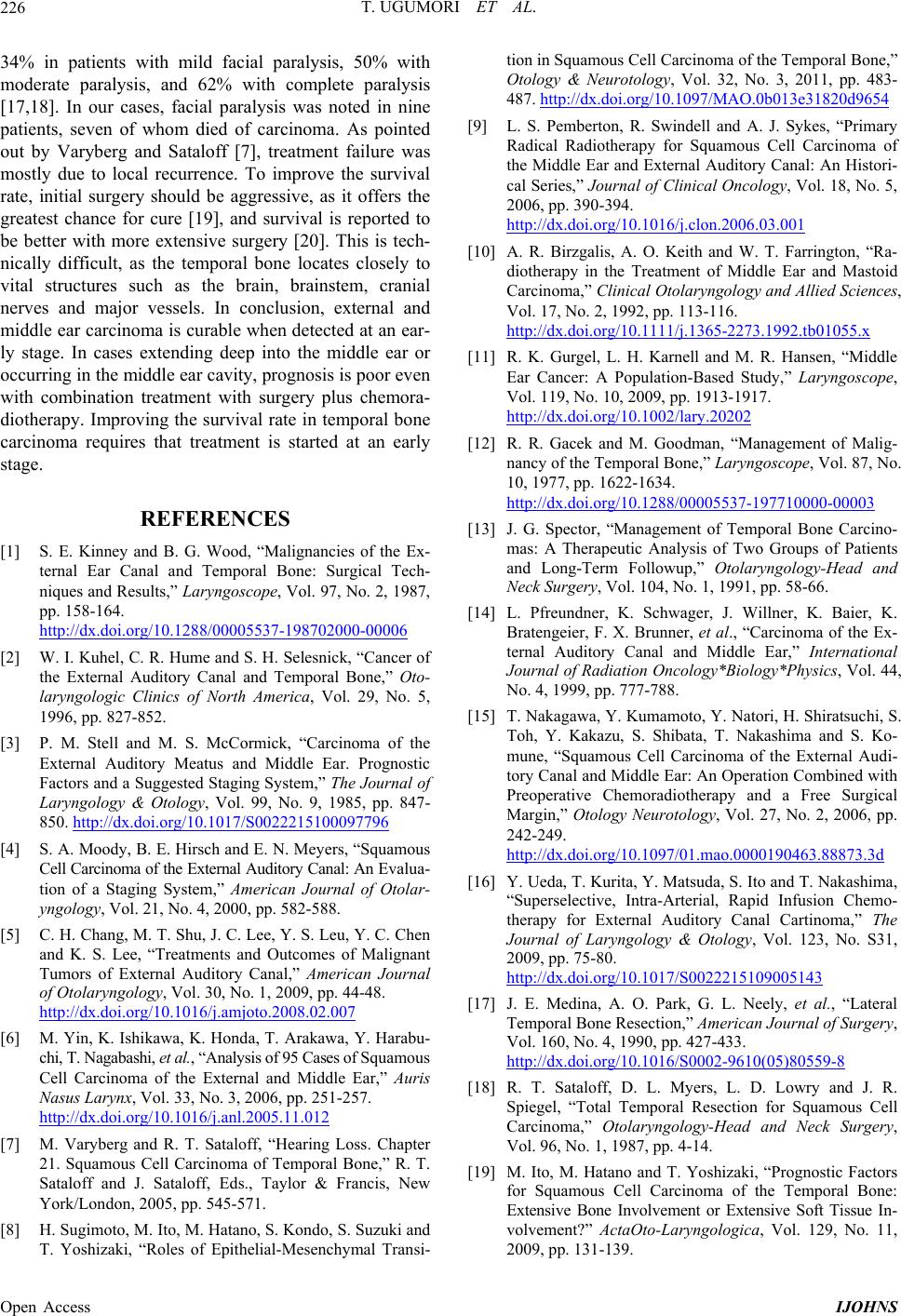
T. UGUMORI ET AL.
226
34% in patients with mild facial paralysis, 50% with
moderate paralysis, and 62% with complete paralysis
[17,18]. In our cases, facial paralysis was noted in nine
patients, seven of whom died of carcinoma. As pointed
out by Varyberg and Sataloff [7], treatment failure was
mostly due to local recurrence. To improve the survival
rate, initial surgery should be aggressive, as it offers the
greatest chance for cure [19], and survival is reported to
be better with more extensive surgery [20]. This is tech-
nically difficult, as the temporal bone locates closely to
vital structures such as the brain, brainstem, cranial
nerves and major vessels. In conclusion, external and
middle ear carcinoma is curable when detected at an ear-
ly stage. In cases extending deep into the middle ear or
occurring in the middle ear cavity, prognosis is poor even
with combination treatment with surgery plus chemora-
diotherapy. Improving the survival rate in temporal bone
carcinoma requires that treatment is started at an early
stage.
REFERENCES
[1] S. E. Kinney and B. G. Wood, “Malignancies of the Ex-
ternal Ear Canal and Temporal Bone: Surgical Tech-
niques and Results,” Laryngoscope, Vol. 97, No. 2, 1987,
pp. 158-164.
http://dx.doi.org/10.1288/00005537-198702000-00006
[2] W. I. Kuhel, C. R. Hume and S. H. Selesnick, “Cancer of
the External Auditory Canal and Temporal Bone,” Oto-
laryngologic Clinics of North America, Vol. 29, No. 5,
1996, pp. 827-852.
[3] P. M. Stell and M. S. McCormick, “Carcinoma of the
External Auditory Meatus and Middle Ear. Prognostic
Factors and a Suggested Staging System,” The Journal of
Laryngology & Otology, Vol. 99, No. 9, 1985, pp. 847-
850. http://dx.doi.org/10.1017/S0022215100097796
[4] S. A. Moody, B. E. Hirsch and E. N. Meyers, “Squamous
Cell Carcinoma of the External Auditory Canal: An Eva l u a-
tion of a Staging System,” American Journal of Otolar-
yngology, Vol. 21, No. 4, 2000, pp. 582-588.
[5] C. H. Chang, M. T. Shu, J. C. Lee, Y. S. Leu, Y. C. Chen
and K. S. Lee, “Treatments and Outcomes of Malignant
Tumors of External Auditory Canal,” American Journal
of Otolaryngology, Vol. 30, No. 1, 2009, pp. 44-48.
http://dx.doi.org/10.1016/j.amjoto.2008.02.007
[6] M. Yin, K. Ishikawa, K. Honda, T. Arakawa, Y. Harabu-
chi, T. Nagabashi, et al., “Analysis of 95 Cases of Squamous
Cell Carcinoma of the External and Middle Ear,” Auris
Nasus Larynx, Vol. 33, No. 3, 2006, pp. 251-257.
http://dx.doi.org/10.1016/j.anl.2005.11.012
[7] M. Varyberg and R. T. Sataloff, “Hearing Loss. Chapter
21. Squamous Cell Carcinoma of Temporal Bone,” R. T.
Sataloff and J. Sataloff, Eds., Taylor & Francis, New
York/London, 2005, pp. 545-571.
[8] H. Sugimoto, M. Ito, M. Hatano, S. Kondo, S. Suzuki and
T. Yoshizaki, “Roles of Epithelial-Mesenchymal Transi-
tion in Squamous Cell Carcinoma of the Temporal Bone,”
Otology & Neurotology, Vol. 32, No. 3, 2011, pp. 483-
487. http://dx.doi.org/10.1097/MAO.0b013e31820d9654
[9] L. S. Pemberton, R. Swindell and A. J. Sykes, “Primary
Radical Radiotherapy for Squamous Cell Carcinoma of
the Middle Ear and External Auditory Canal: An Histori-
cal Series,” Journal of Clinical Oncology, Vol. 18, No. 5,
2006, pp. 390-394.
http://dx.doi.org/10.1016/j.clon.2006.03.001
[10] A. R. Birzgalis, A. O. Keith and W. T. Farrington, “Ra-
diotherapy in the Treatment of Middle Ear and Mastoid
Carcinoma,” Clinical Otolaryngology and Allied Sciences,
Vol. 17, No. 2, 1992, pp. 113-116.
http://dx.doi.org/10.1111/j.1365-2273.1992.tb01055.x
[11] R. K. Gurgel, L. H. Karnell and M. R. Hansen, “Middle
Ear Cancer: A Population-Based Study,” Laryngoscope,
Vol. 119, No. 10, 2009, pp. 1913-1917.
http://dx.doi.org/10.1002/lary.20202
[12] R. R. Gacek and M. Goodman, “Management of Malig-
nancy of the Temporal Bone,” Laryngoscope, Vol. 87, No.
10, 1977, pp. 1622-1634.
http://dx.doi.org/10.1288/00005537-197710000-00003
[13] J. G. Spector, “Management of Temporal Bone Carcino-
mas: A Therapeutic Analysis of Two Groups of Patients
and Long-Term Followup,” Otolaryngology-Head and
Neck Surgery, Vol. 104, No. 1, 1991, pp. 58-66.
[14] L. Pfreundner, K. Schwager, J. Willner, K. Baier, K.
Bratengeier, F. X. Brunner, et al., “Carcinoma of the Ex-
ternal Auditory Canal and Middle Ear,” International
Journal of Radiation Oncology*Biology*Physics, Vol. 44,
No. 4, 1999, pp. 777-788.
[15] T. Nakagawa, Y. Kumamoto, Y. Natori, H. Shiratsuchi, S.
Toh, Y. Kakazu, S. Shibata, T. Nakashima and S. Ko-
mune, “Squamous Cell Carcinoma of the External Audi-
tory Canal and Middle Ear: An Operation Combined with
Preoperative Chemoradiotherapy and a Free Surgical
Margin,” Otology Neurotology, Vol. 27, No. 2, 2006, pp.
242-249.
http://dx.doi.org/10.1097/01.mao.0000190463.88873.3d
[16] Y. Ueda, T. Kurita, Y. Matsuda, S. Ito a nd T. Naka shima,
“Superselective, Intra-Arterial, Rapid Infusion Chemo-
therapy for External Auditory Canal Cartinoma,” The
Journal of Laryngology & Otology, Vol. 123, No. S31,
2009, pp. 75-80.
http://dx.doi.org/10.1017/S0022215109005143
[17] J. E. Medina, A. O. Park, G. L. Neely, et al., “Lateral
Temporal Bone Resection,” American Journal of Surgery,
Vol. 160, No. 4, 1990, pp. 427-433.
http://dx.doi.org/10.1016/S0002-9610(05)80559-8
[18] R. T. Sataloff, D. L. Myers, L. D. Lowry and J. R.
Spiegel, “Total Temporal Resection for Squamous Cell
Carcinoma,” Otolaryngology-Head and Neck Surgery,
Vol. 96, No. 1, 1987, pp. 4-14.
[19] M. Ito, M. Hatano and T. Yoshizaki, “Prognostic Factors
for Squamous Cell Carcinoma of the Temporal Bone:
Extensive Bone Involvement or Extensive Soft Tissue In-
volvement?” ActaOto-Laryngologica, Vol. 129, No. 11,
2009, pp. 131-139.
Open Access IJOHNS